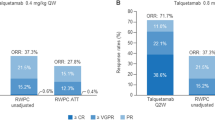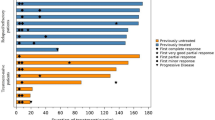Abstract
In the treatment of hematological malignancies, the significance of achieving molecular complete remissions rather than a clinical complete remission has become increasingly apparent, as relapse is considered to be related to the presence and extent of residual, persistent malignant cells. Progress in the use of alemtuzumab (MabCampath™) to eradicate minimal residual disease in chronic lymphocytic leukemia (CLL) has positive implications for patients, particularly prior to stem cell transplantation. Another beneficial aspect of monoclonal antibody therapy under active investigation is the ability of alemtuzumab to repeatedly produce or maintain responses. Subcutaneous administration of alemtuzumab is now emerging as a key advancement in the treatment of CLL. A phase II trial of subcutaneous alemtuzumab has demonstrated an 87% response rate in 38 previously untreated patients, with a reduction in intravenous administration-related rigors, as well as the elimination of nausea, dyspnea, diarrhea, and hypotension, frequently seen following intravenous administration of alemtuzumab. This trial demonstrates the advantages for safety, cost, flexibility, and convenience offered by subcutaneous administration of alemtuzumab. Finally, encouraging results with the combination of alemtuzumab and fludarabine, which demonstrate eradication of malignant cells in patients who are resistant to either agent alone, open the way for such combinations to produce durable responses even in refractory disease.
Similar content being viewed by others
References
Keating, M.J., et al. (2002). Therapeutic role of alemtuzumab (Campath-1H) in patients who have failed fludarabine: results of a large international study. Blood, in press.
Dyer, M., et al. (1997). In vivo “purging” of residual disease in CLL with Campath-1H. Br. J. Haematol. 97(3):669–672.
Kennedy, S., et al. (1999). Campath-1H therapy in 29 patients with refractory CLL: ‘true’ complete remission is an attainable goal. Blood 94(10, Suppl. 1):603a (abstract).
Grove, D.S. (1999). Quantitative real-time polymerase chain reaction for the core facility using TaqMan and the Perkin-Elmer/Applied Biosystems Division 7700 Sequence Detector. J. Biomol. Tech. 10:11–16.
Pfitzner, T., et al. (2000). Monitoring residual tumor cells in patients with chronic lymphatic leukemia during remission using a newly developed real-time PCR method. Blood 96 (Abstract).
O’Brien, S.M., et al. (2001). Campath-1H for minimal residual disease in CLL. Am. J. Clin. Oncol. 20(1):284a (abstract).
Pangalis, G.A., Dimopoulou, M.N., Angelopoulou, M.K. and Siakantaris, M.P. (2000). Campath-1H in B-chronic lymphocytic leukemia: report on a patient treated thrice in a 3 year period. Med. Oncol. 17:70–73.
Hoffman, M., Jansen, D. and Rai, K. (1999). Analysis of response to Campath-1H in patients with B-CLL progressing after fludarabine therapy. Hematol. Cell. Ther. 67 (abstract).
Tison, B., Bolin, R., Lill, J. and Ottermiller, S. (2001). Benefits of repeated courses of alemtuzumab (Campath) in patients with relapsed/refractory B-CLL. Blood 98:292b (abstract).
Lundin, J., et al. (2000). CAMPATH-1H therapy of patients with previously untreated chronic lymphocytic leukemia (CLL). Ann. Oncol. 11(Suppl. 4):96 (abstract).
Bowen, A.L., et al. (1997). Subcutaneous CAMPATH-1H in fludarabine-resistant/relapsed chronic lymphocytic and B-prolymphocytic leukaemia. Br. J. Haematol. 96(3):617–619.
Osterborg, A., et al. (1996). Humanized CD52 monoclonal antibody Campath-1H as first-line treatment in chronic lymphocytic leukaemia. Br. J. Haematol. 93(1):151–153.
Kennedy, B., et al. (2000). Campath-1H with fludarabine: a novel, highly active combination in refractory CLL. Blood 96 (abstract).
Cheson, B.D., et al. (1996). National Cancer Institute-sponsored Working Group guidelines for chronic lymphocytic leukemia: revised guidelines for diagnosis and treatment. Blood 87(12):4990–4997.
Garcia-Manero, G., et al. (2000). Combination fludarabine, cyclophosphamide and rituximab for previously treated patients with chronic lymphocytic leukemia (CLL). Blood 96 (abstract).
Author information
Authors and Affiliations
Corresponding author
Rights and permissions
About this article
Cite this article
Rai, K., Hallek, M. Future prospects for alemtuzumab (MabCampath™). Med Oncol 19 (Suppl 2), S57–S63 (2002). https://doi.org/10.1385/MO:19:2S:S57
Issue Date:
DOI: https://doi.org/10.1385/MO:19:2S:S57




